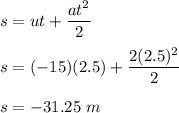
Physics, 20.10.2020 01:01 jennyderath12
A driver of a car traveling at -15m/s applies the brakes, causing a uniform acceleration of +2.0m/s2. If the brakes are applied for 2.5s, what is the velocity of the car at the end of the braking period? How far has the car moved during the braking period?

Answers: 1


Another question on Physics

Physics, 22.06.2019 11:00
What would be the result of an alpha particle coming into a magnetic field? a) the alpha particle will stop moving. b) the alpha particle will reverse its direction. c) the alpha particle will be deflected in a curve path. d) the alpha particle will continue to travel in a straight line.
Answers: 1

Physics, 22.06.2019 16:00
Marvin records scientific data about lake superior. for which property has marvin forgotten to use an si unit of measurement? shore length high temperature low temperature annual precipitation
Answers: 3

Physics, 22.06.2019 20:30
Avehicle accelerates from 0 to 30 m/s in 10 seconds on a straight road
Answers: 2

Physics, 22.06.2019 21:00
Acentrifuge in a medical laboratory rotates at an angular speed of 3,700 rev/min. when switched off, it rotates through 54.0 revolutions before coming to rest. find the constant angular acceleration (in rad/s2) of the centrifuge. your response is within 10% of the correct value. this may be due to roundoff error, or you could have a mistake in your calculation. carry out all intermediate results to at least four-digit accuracy to minimize roundoff error. rad/s2
Answers: 1
You know the right answer?
A driver of a car traveling at -15m/s applies the brakes, causing a uniform acceleration of +2.0m/s2...
Questions



Arts, 06.02.2022 14:00


Mathematics, 06.02.2022 14:00

Mathematics, 06.02.2022 14:00

Mathematics, 06.02.2022 14:00

Mathematics, 06.02.2022 14:00




Mathematics, 06.02.2022 14:00







Chemistry, 06.02.2022 14:00

Mathematics, 06.02.2022 14:00





